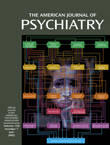Galantamine for Treatment-Resistant Schizophrenia
To the Editor: Abnormal neurotransmission at nicotinic cholinergic receptors may contribute to the pathophysiology of schizophrenia (1). Clozapine may favorably affect these abnormal nicotinic mechanisms (2). We report here on two treatment-resistant patients with schizophrenia whose successful treatment with clozapine had been discontinued because of agranulocytosis. Both fared poorly while taking other antipsychotics. Both showed therapeutic benefit when galantamine, a noncompetitive agonist/allosteric modulator at nicotinic cholinergic receptors (3), was added to their treatment with risperidone.
Mr. A was a 28-year-old man with persistent auditory hallucinations and persecutory delusions who had been given repeated placement in the community, but these efforts had failed because of frequent episodes of agitation, threatening behavior, and destruction of property that seemed to be driven by paranoia and his hearing “voices.” Galantamine was introduced and brought to an oral dose of 8 mg b.i.d. over 2 weeks. The episodes of agitation disappeared, and Mr. A became more capable of sustained routine conversation in which he could rationally evaluate his psychopathology. After an additional 2 weeks of treatment, he was successfully placed in a group home, where he has continued to do well for 2 months.
Mr. B was a 53-year-old man with profoundly disorganized thoughts and poor self-care, including wearing multiple layers of clothing inside out and backward. He repeatedly wandered away from the group home where he had been placed. Galantamine treatment was initiated and brought to an oral dose of 12 mg b.i.d. Mr. B’s thoughts became more organized. He wore his clothes correctly and was more social with staff and other patients. Staff at the group home report that since returning there, he no longer wanders away and, in fact, signs out when taking local walks. He remains more social and has maintained clearly improved dressing and hygiene.
The active components of risperidone and galantamine exhibit no change in their bioavailabilities when co-administered (4). Galantamine alters the structure of nicotinic receptors, making them more receptive to nicotinic agonists, in addition to inhibiting the breakdown of acetylcholine by its cholinesterase (5).
Controlled double-blind trials of galantamine as an adjunctive treatment for schizophrenia are currently underway. These two patients were both very heavy smokers and had shown a favorable therapeutic response to clozapine that could not be matched by treatment with any other currently available antipsychotic. Both of these attributes (smoking and clozapine response) may signal that nicotinic pathophysiology contributed to their illnesses and that an agent such as galantamine that can augment nicotinic function may be a useful treatment (6).
1. Adler LE, Olincy A, Waldo M, Harris JG, Griffith J, Stevens K, Flach K, Nagamoto H, Bickford P, Leonard S, Freedman R: Schizophrenia, sensory gating, and nicotinic receptors. Schizophr Bull 1998; 24:189-202Crossref, Medline, Google Scholar
2. Nagamoto HT, Adler LE, Hea RA, Griffith JM, McRae KA, Freedman R: Gating of auditory P50 in schizophrenia: unique effects of clozapine. Biol Psychiatry 1996; 40:181-188Crossref, Medline, Google Scholar
3. Maelicke A, Albuquerque EX: Allosteric modulation of nicotinic acetylcholine receptors as a treatment strategy for Alzheimer’s disease. Eur J Pharmacol 2000; 393:165-170Crossref, Medline, Google Scholar
4. Huang F, Lasseter KL, Janssens L, Verhaeghe T, Lau H, Zhao Q: Pharmacokinetic and safety assessments of galantamine and risperidone after the two drugs were administered alone and together. J Clin Pharmacol (in press)Google Scholar
5. Arias HR: Localization of agonist and competitive antagonist binding sites on nicotinic acetylcholine receptors. Neurochem Int 2000: 36:595-645Google Scholar
6. McEvoy JP, Freudenreich O, Wilson WH: Smoking and therapeutic response to clozapine in patients with schizophrenia. Biol Psychiatry 1999; 46:125-129Crossref, Medline, Google Scholar



